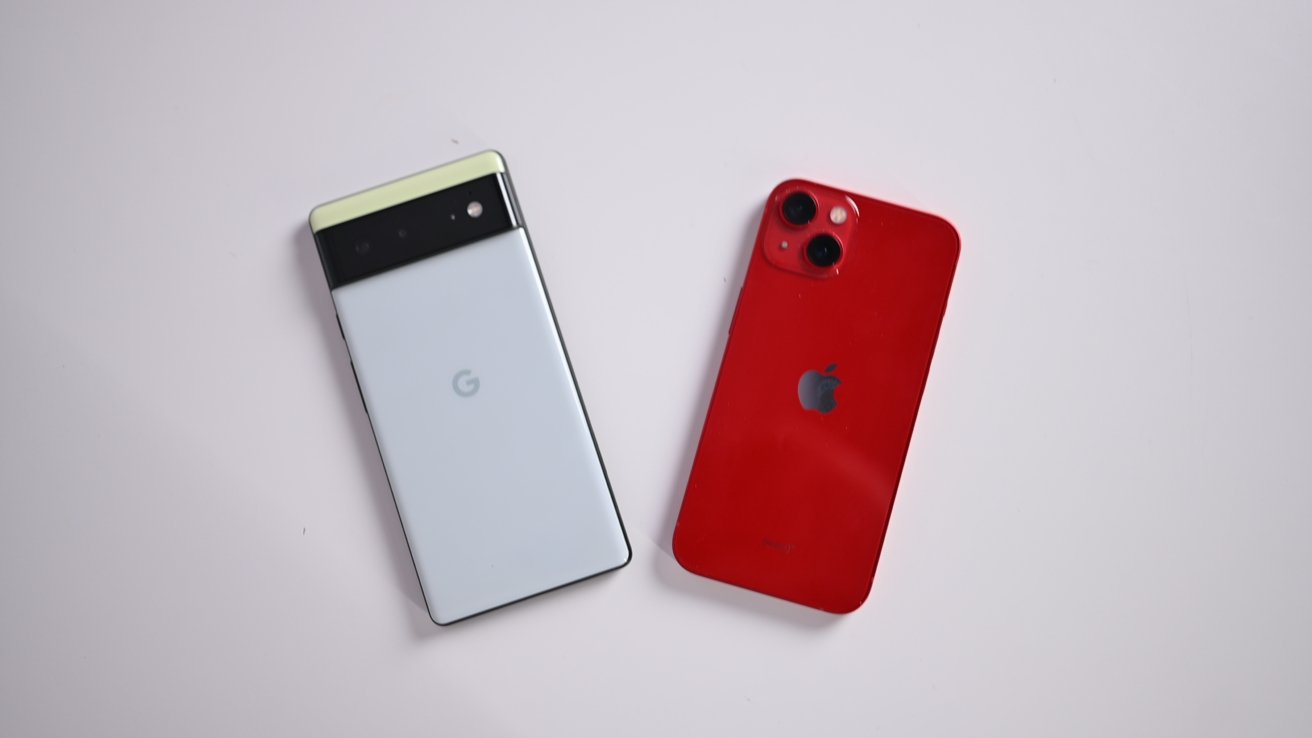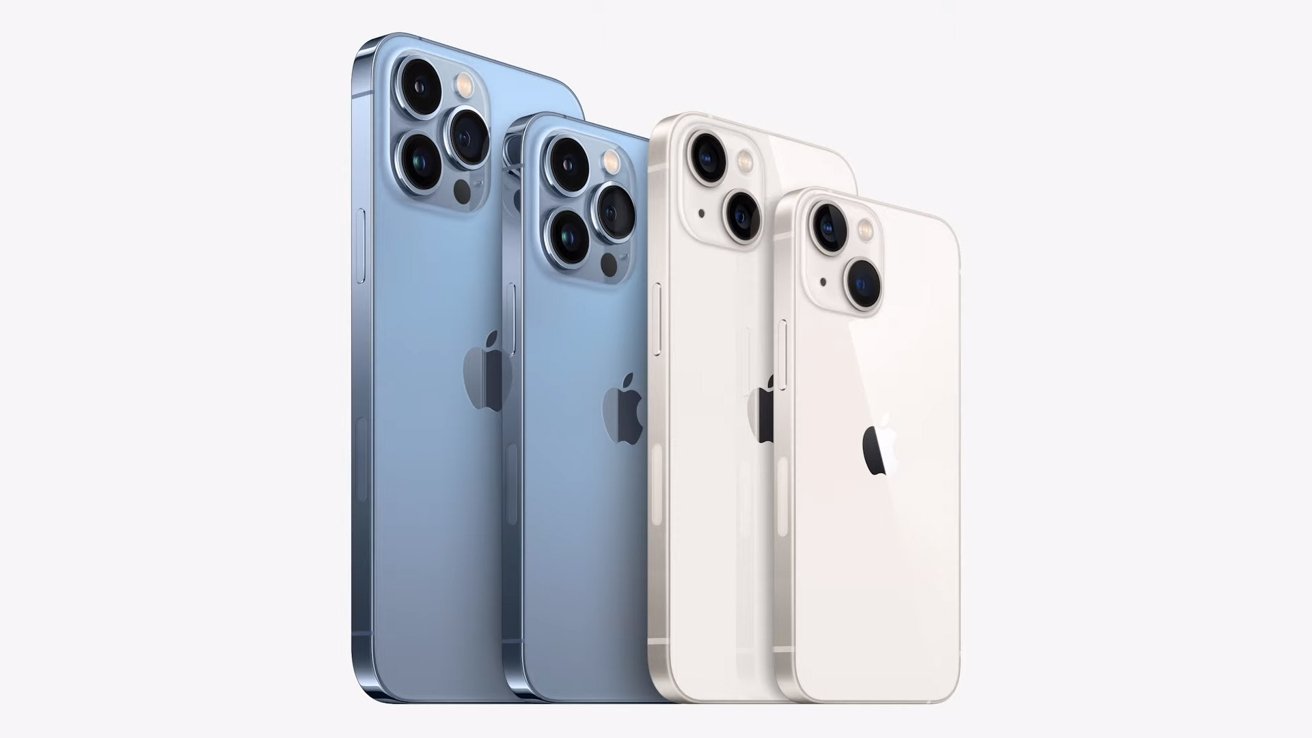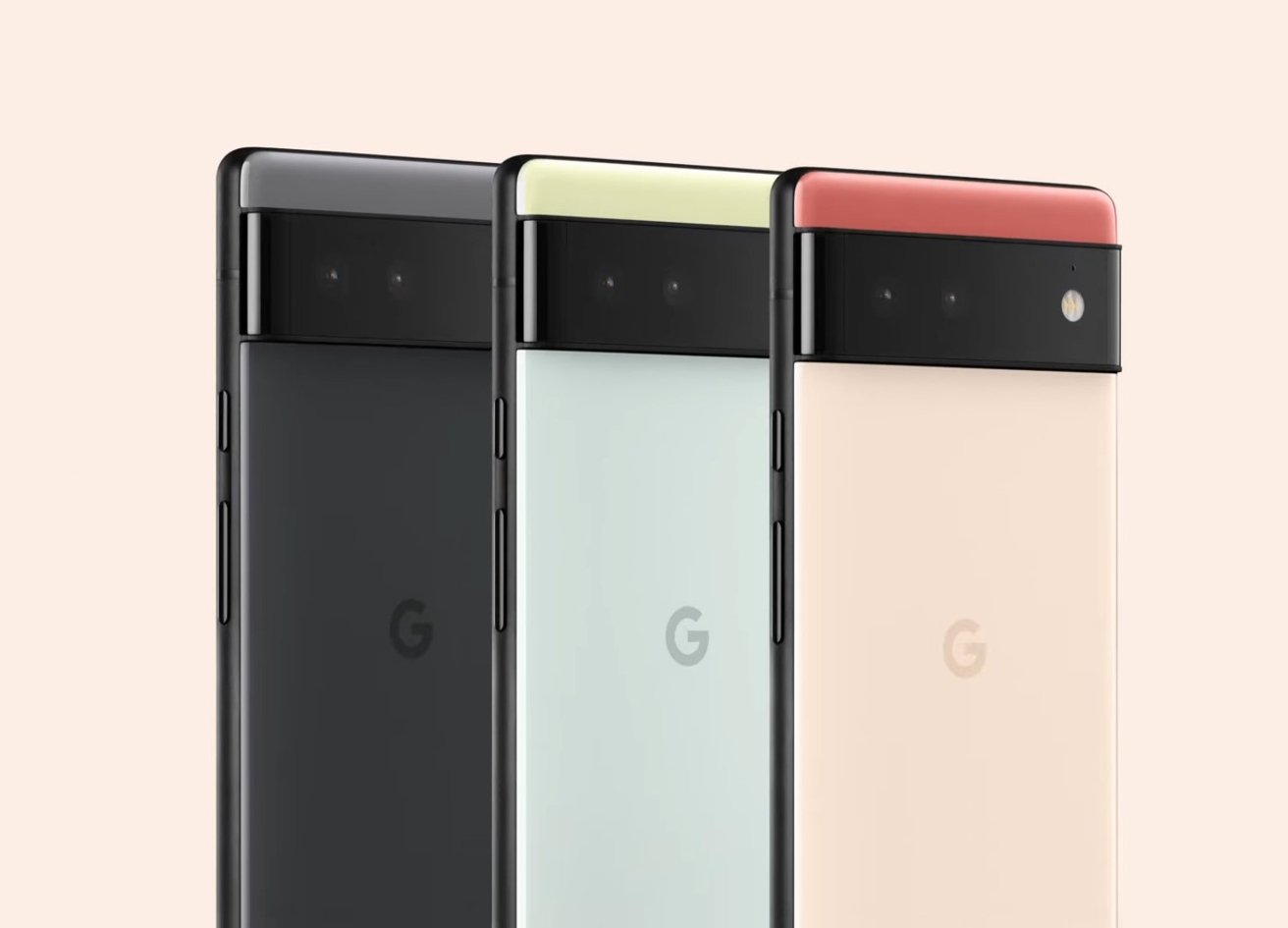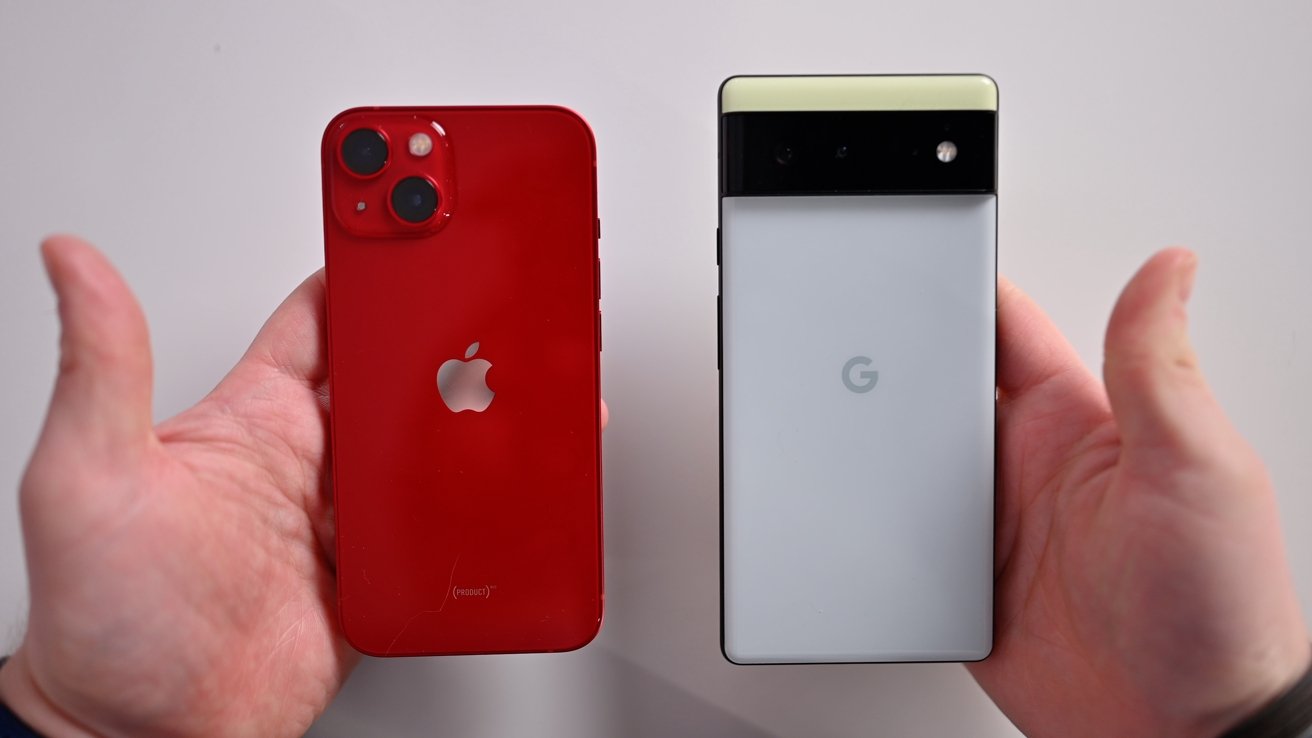Compared: Google Pixel 6 vs iPhone 13 and iPhone 13 Pro
Google launched its new Pixel 6 lineup on Tuesday, with its smartphone range now sporting its own Tensor processor. Here's how the search giant's latest compares against Apple's iPhone 13 and the iPhone 13 Pro.

Pixel 6 and iPhone 13
Tuesday saw Google formally introduce the Pixel 6. Teased at Google I/O over the summer, the new smartphone is set to be a departure for the company, as instead of relying on a Snapdragon processor, it's using something entirely new: a Google-designed chip.
Launching a month after Apple's product line update, it's worth comparing what Google's offering against its main opposition, the iPhone 13 and iPhone 13 Pro.
Both iPhone 13 and Pro are 5.78 inches long and 2.92 inches wide. They're also 0.3 inches thick.
The Pixel 6 is somewhat larger, at 6.2 inches tall, but marginally slimmer at 2.9 inches. As for thickness, it's quite a bit chunkier than the iPhones, at 0.4 inches.
On the weight side, the iPhone 13 is the lightest, at 6.14 ounces, followed by the iPhone 13 Pro at 7.19 ounces. Naturally, the bigger Pixel 6 is also the heaviest, at 7.3 ounces.
While size is a determining factor in weight, so is construction. While the iPhone 13 uses an aerospace-grade aluminum frame and the iPhone 13 Pro opts for surgical-grade stainless steel, Google went for a "tactile alloy frame."
Apple's iPhone 13 and iPhone 13 Pro represent the company's latest and greatest tech.
One of the reasons for Google's difference in size is due to its display, which is simply larger than Apple's version.
Both the iPhone 13 and iPhone 13 Pro use a 6.1-inch Super Retina XDR display, an OLED panel that supports HDR, True Tone, Wide Color P3, and a 2,000,000:1 contrast ratio. The iPhone 13 has a maximum brightness of 800 nits for normal content, rising to 1,200 nits for HDR.
The Pro goes further, in offering 1,000 nits of typical brightness with the same 1,200-nit HDR ceiling. Furthermore, it also supports ProMotion, allowing it to change the refresh rate of the display on the fly, at a rate of up to 120Hz.
Google's 6.4-inch display is larger, with it offering a greater-than 1,000,00:1 contrast ratio, HDR support, and can operate at up to 90Hz if required. It's also an always-on display, so users can easily see brief notifications without needing to light up the entire screen.
While larger, Google doesn't quite beat the iPhones on resolution. Both iPhones have a resolution of 2,778 by 1,128 pixels, giving them a pixel density of 456 pixels per inch.
Meanwhile the Pixel 6 has a resolution of 2,400 by 1,080, with a 411ppi pixel density.
Theres also elements such as Night Mode, Deep Fusion computational photography, Portrait Mode with Portrait Lighting, and the new Photographic Styles. The Sensor-shift optical image stabilization is also an upgrade for 2021.
For zooming, the iPhone 13 has a 2x optical zoom out and a 5x digital zoom. The Pro has a 3x optical zoom in along with the 2x optical zoom out. This gives it a 6x optical zoom range, and a maximum digital zoom of 15x.
Google includes two cameras on the back of the Pixel 6, starting with the 12-megapixel ultra-wide camera. That camera offers a 114-degree field of view and an f/2.2 aperture.
The main attraction in the Pixel 6 is the 50-megapixel Octa PD Quad Bayer wide camera, which features a 1/1.3-inch sensor capable of capturing 150% more light than the version in the Pixel 5, as well as OIS and a laser detect autofocus (LDAF) sensor.
While the high resolution of the sensor sounds big, it's really performing pixel binning and outputting an image at 12.5 megapixels. That picture should be very high quality, but not one at such a sky-high resolution.
As usual for the Pixel lineup, Google focuses a lot on its various features in terms of computational photography. There's typical items like Night Sight, Portrait Mode, and Motion Autofocus, along with more elaborate features like Top Shot or Magic Eraser, which can remove unwanted elements from the shot.
There's also Face Unblur to make faces sharper, Real Tone, and Motion Mode, which combines multiple sharp images to identify the subject and keep them sharp while applying motion blur effects to the background.
Let's take a look at some sample shots between the iPhone 13 and the Pixel 6.
The above photo is medium-lit indoor shot of a candle. Coloring and noise may slightly favor the Pixel 6, but it also seems to be trying to artificially blur the background. The edges of the candle aren't very sharp and creates a less realistic image than the iPhone.
We took both phones outdoors to test night mode. Handheld, night mode was automatically enabled on each device and had roughly a three second shutter. The Pixel struggled significantly, producing a very poorly lit photo while the iPhone 13 did marginally better.
Afterwords, we placed the phones on a solid surface for an extended long exposure shot. The Pixel 6 did better, but was still largely unusable. It did produce less noise in the sky however. This doesn't matter though if the image is overly dark. The iPhone 13's image is much more usable with crisp edges on the tree and shed.
We wanted to test the zoom on the phone and this is where the Pixel 6 shined most.
In the above photo, both phones zoomed in at 5X digital zoom. This was the max for the iPhone but the Pixel could go further. At this 5X distance, the Pixel 6 was by far the better image. It was more crisp with less noise and blur in the leaves. The iPhone struggled a lot and when you examine the photo it almost looks like a poor watercolor painting than a photo.
At the front, Apple employs its TrueDepth camera array, with a 12-megapixel photo capability and f/2.2 aperture, along with its depth-sensing capability for Face ID and other applications. Google uses an 8-megapixel f/2.0 with an 84-degree field of view.
The Pixel 6, and its Pixel 6 Pro stablemate, are the first to sport a custom Google chip.
The iPhone 13 and iPhone 13 pro use the A15 Bionic, Apple's self-designed SoC. It includes a six-core processor with a four-core GPU in the iPhone 13, 5-core GPU in the Pro, along with an updated 16-core Neural Engine and am improved image signal processor to assist with computational photography.
The Pixel 6 is the first to use Google's new Tensor SoC, which is the search company's attempt to take on Apple with its own chip creation.
Tensor consists of a CPU with two high-performance cores, two mid cores, and four high-efficiency cores. To go with that is a 20-core GPU, as well as a number of other elements to help with machine learning or other tasks.
This includes the Titan M2 chip for security, an image signal processor, and a "Context Hub" that handles various elements like the display's always-on features, without tasking the CPU or GPU.
There's no benchmarks for the Tensor chip to go on in order to compare it with the A15, but Google has certainly promoted its machine learning chops for the chip. For example, it performs on-device automatic speech recognition for Google Assistant, can create live captions for media, and live translate conversations, among other tasks.
Google's Pixel 6 Pro supports up to 30W of charge over USB-C, while the iPhone 13 and iPhone 13 Pro support up to 20W of fast charging. Apple's two iPhones support up to 15W of wireless charging, while the Pixel 6 tops out at 12W.
All three smartphones have an IP67 rating for water- and dust-resistance. Google uses Corning Gorilla Glass Victus, while Apple has gone with a Ceramic Shield front glass.
The iPhone 13 and iPhone 13 Pro support mmWave and sub-6GHz 5G. Not every Pixel 6 supports mmWave, but Verizon is said to be releasing a special variant that does. The Pixel 6 does have Wi-Fi 6E and Bluetooth 5.2, while the iPhone models have Wi-Fi 6 and Bluetooth 5. Apple's devices have UWB support, while the Pixel 6 does not.
When it comes to biometrics, the iPhone 13 Pro and iPhone 13 both rely on Face ID. The Pixel 6 uses a new under-display fingerprint sensor instead.
Pixel 6 or iPhone 13?
Pound-for-pound, Apple's iPhones are some of the best smartphones on the market in terms of cameras, performance, and feature set. While the Pixel 6 is priced as a midrange device, it does sport some premium features that could make it an attractive option for many consumers.
Of course, some aspects of the two device lineups differ and can't be readily compared. Android versus iOS, for example, largely comes down to personal preference. While the Pixel 6 stands out as an Android device, there are probably better choices for those who are deeply embedded in the Apple ecosystem. Although a few hundred dollars more, the iPhone 13 represents the entry-level when it comes to Apple's 2021 iPhones -- and brings with it all the benefits of iOS and integration with Apple's other devices.
However, the Pixel 6's $599 price point is certainly impressive when you consider its powerful chip, large battery, under-display fingerprint sensor, and camera chops. Put simply, it's Google's latest and greatest. As with previous Pixel models, it's very likely that the Pixel 6 is not an "iPhone killer," despite being a solid choice for Android users.
Read on AppleInsider
Pixel 6 and iPhone 13
Tuesday saw Google formally introduce the Pixel 6. Teased at Google I/O over the summer, the new smartphone is set to be a departure for the company, as instead of relying on a Snapdragon processor, it's using something entirely new: a Google-designed chip.
Launching a month after Apple's product line update, it's worth comparing what Google's offering against its main opposition, the iPhone 13 and iPhone 13 Pro.
Specification
| Google Pixel 6 | iPhone 13 | iPhone 13 Pro | |
|---|---|---|---|
| Price (Starting) | $599 | $799 | $999 |
| Dimensions (Inches) | 6.2 x 2.9 x 0.4 | 5.78 x 2.82 x 0.30 | 5.78 x 2.82 x 0.30 |
| Weight (Ounces) | 7.30 | 6.14 | 7.19 |
| Processor | Google Tensor | A15 Bionic | A15 Bionic |
| Storage | 128GB, 256GB | 128GB, 256GB, 512GB | 128GB, 256GB, 512GB, 1TB |
| Display | 6.4-inch always-on OLED | 6.1-inch Super Retina XDR | 6.1-inch Super Retina XDR with ProMotion |
| Resolution | 2,400 x 1,080, 411PPI | 2,778 x 1,128, 458PPI | 2,778 x 1,128, 458PPI |
| Biometrics | Under-display Fingerprint Unlock | Face ID | Face ID |
| Rear Cameras | 12MP Ultra-Wide, 50MP Octa PD Quad Bayer Wide, | 12MP Ultra-Wide 12MP Wide | 12MP Ultra-Wide 12MP Wide 12MP Telephoto LiDAR |
| Video | 4K 60FPS, 240FPS Slo-Mo, Cinematic Pan | 4K 60FPS, 4K 60FPS HDR with Dolby Vision, 240FPS Slo-Mo, Cinematic Mode | 4K 60FPS, 4K 60FPS HDR with Dolby Vision, 240FPS Slo-Mo, ProRes 4K 30FPS, Cinematic Mode |
| Front Camera | 8MP | 12MP TrueDepth | 12MP TrueDepth |
| Battery Life | 24+ hours | Up to 19 hours | Up to 22 hours |
| Wireless Connectivity | 5G, Wi-Fi 6E, Bluetooth 5.2, NFC | 5G, Wi-Fi 6, Bluetooth 5.0, Ultra Wideband, NFC | 5G, Wi-Fi 6, Bluetooth 5.0, Ultra Wideband, NFC |
| Port | USB Type-C 3.1 Gen 1 | Lightning | Lightning |
| Colors | Sorta Seafoam, Kinda Coral, Stormy Black | Starlight, Midnight, Blue, Pink, (PRODUCT)Red | Graphite, Silver, Gold, Sierra Blue |
Pixel 6 vs iPhone 13 vs iPhone 13 Pro - Physical Dimensions
As the middle two in Apple's iPhone 13 range, the iPhone 13 and iPhone 13 Pro have the distinction in this comparison in having many similarities. That starts with the physical design.Both iPhone 13 and Pro are 5.78 inches long and 2.92 inches wide. They're also 0.3 inches thick.
The Pixel 6 is somewhat larger, at 6.2 inches tall, but marginally slimmer at 2.9 inches. As for thickness, it's quite a bit chunkier than the iPhones, at 0.4 inches.
On the weight side, the iPhone 13 is the lightest, at 6.14 ounces, followed by the iPhone 13 Pro at 7.19 ounces. Naturally, the bigger Pixel 6 is also the heaviest, at 7.3 ounces.
While size is a determining factor in weight, so is construction. While the iPhone 13 uses an aerospace-grade aluminum frame and the iPhone 13 Pro opts for surgical-grade stainless steel, Google went for a "tactile alloy frame."
Pixel 6 vs iPhone 13 vs iPhone 13 Pro - Displays

Apple's iPhone 13 and iPhone 13 Pro represent the company's latest and greatest tech.
One of the reasons for Google's difference in size is due to its display, which is simply larger than Apple's version.
Both the iPhone 13 and iPhone 13 Pro use a 6.1-inch Super Retina XDR display, an OLED panel that supports HDR, True Tone, Wide Color P3, and a 2,000,000:1 contrast ratio. The iPhone 13 has a maximum brightness of 800 nits for normal content, rising to 1,200 nits for HDR.
The Pro goes further, in offering 1,000 nits of typical brightness with the same 1,200-nit HDR ceiling. Furthermore, it also supports ProMotion, allowing it to change the refresh rate of the display on the fly, at a rate of up to 120Hz.
Google's 6.4-inch display is larger, with it offering a greater-than 1,000,00:1 contrast ratio, HDR support, and can operate at up to 90Hz if required. It's also an always-on display, so users can easily see brief notifications without needing to light up the entire screen.
While larger, Google doesn't quite beat the iPhones on resolution. Both iPhones have a resolution of 2,778 by 1,128 pixels, giving them a pixel density of 456 pixels per inch.
Meanwhile the Pixel 6 has a resolution of 2,400 by 1,080, with a 411ppi pixel density.
Pixel 6 vs iPhone 13 vs iPhone 13 Pro - Cameras
On the back of both iPhones are 12-megapixel Ultra-Wide and 12-megapixel Wide cameras, with the Pro gaining an extra 12-megapixel Telephoto camera and a LiDAR sensor. The last element assists the computational photography elements, drives AR applications, and helps focus the camera in low-light situations.Theres also elements such as Night Mode, Deep Fusion computational photography, Portrait Mode with Portrait Lighting, and the new Photographic Styles. The Sensor-shift optical image stabilization is also an upgrade for 2021.
For zooming, the iPhone 13 has a 2x optical zoom out and a 5x digital zoom. The Pro has a 3x optical zoom in along with the 2x optical zoom out. This gives it a 6x optical zoom range, and a maximum digital zoom of 15x.
Google includes two cameras on the back of the Pixel 6, starting with the 12-megapixel ultra-wide camera. That camera offers a 114-degree field of view and an f/2.2 aperture.
The main attraction in the Pixel 6 is the 50-megapixel Octa PD Quad Bayer wide camera, which features a 1/1.3-inch sensor capable of capturing 150% more light than the version in the Pixel 5, as well as OIS and a laser detect autofocus (LDAF) sensor.
While the high resolution of the sensor sounds big, it's really performing pixel binning and outputting an image at 12.5 megapixels. That picture should be very high quality, but not one at such a sky-high resolution.
As usual for the Pixel lineup, Google focuses a lot on its various features in terms of computational photography. There's typical items like Night Sight, Portrait Mode, and Motion Autofocus, along with more elaborate features like Top Shot or Magic Eraser, which can remove unwanted elements from the shot.
There's also Face Unblur to make faces sharper, Real Tone, and Motion Mode, which combines multiple sharp images to identify the subject and keep them sharp while applying motion blur effects to the background.
Let's take a look at some sample shots between the iPhone 13 and the Pixel 6.
The above photo is medium-lit indoor shot of a candle. Coloring and noise may slightly favor the Pixel 6, but it also seems to be trying to artificially blur the background. The edges of the candle aren't very sharp and creates a less realistic image than the iPhone.
We took both phones outdoors to test night mode. Handheld, night mode was automatically enabled on each device and had roughly a three second shutter. The Pixel struggled significantly, producing a very poorly lit photo while the iPhone 13 did marginally better.
Afterwords, we placed the phones on a solid surface for an extended long exposure shot. The Pixel 6 did better, but was still largely unusable. It did produce less noise in the sky however. This doesn't matter though if the image is overly dark. The iPhone 13's image is much more usable with crisp edges on the tree and shed.
We wanted to test the zoom on the phone and this is where the Pixel 6 shined most.
In the above photo, both phones zoomed in at 5X digital zoom. This was the max for the iPhone but the Pixel could go further. At this 5X distance, the Pixel 6 was by far the better image. It was more crisp with less noise and blur in the leaves. The iPhone struggled a lot and when you examine the photo it almost looks like a poor watercolor painting than a photo.
At the front, Apple employs its TrueDepth camera array, with a 12-megapixel photo capability and f/2.2 aperture, along with its depth-sensing capability for Face ID and other applications. Google uses an 8-megapixel f/2.0 with an 84-degree field of view.
Pixel 6 vs iPhone 13 vs iPhone 13 Pro - Processors
The Pixel 6, and its Pixel 6 Pro stablemate, are the first to sport a custom Google chip.
The iPhone 13 and iPhone 13 pro use the A15 Bionic, Apple's self-designed SoC. It includes a six-core processor with a four-core GPU in the iPhone 13, 5-core GPU in the Pro, along with an updated 16-core Neural Engine and am improved image signal processor to assist with computational photography.
The Pixel 6 is the first to use Google's new Tensor SoC, which is the search company's attempt to take on Apple with its own chip creation.
Tensor consists of a CPU with two high-performance cores, two mid cores, and four high-efficiency cores. To go with that is a 20-core GPU, as well as a number of other elements to help with machine learning or other tasks.
This includes the Titan M2 chip for security, an image signal processor, and a "Context Hub" that handles various elements like the display's always-on features, without tasking the CPU or GPU.
There's no benchmarks for the Tensor chip to go on in order to compare it with the A15, but Google has certainly promoted its machine learning chops for the chip. For example, it performs on-device automatic speech recognition for Google Assistant, can create live captions for media, and live translate conversations, among other tasks.
Pixel 6 vs iPhone 13 vs iPhone 13 Pro - Other Considerations
The Pixel 6 has a 4,614 mAh battery. Apple's iPhone 13 Pro has a 3,095 mAh battery. The iPhone 13's exact battery specifications aren't known, but Apple has rated it to last up to 19 hours of video playback -- slightly lower than the iPhone 13 Pro's 22 hours.Google's Pixel 6 Pro supports up to 30W of charge over USB-C, while the iPhone 13 and iPhone 13 Pro support up to 20W of fast charging. Apple's two iPhones support up to 15W of wireless charging, while the Pixel 6 tops out at 12W.
All three smartphones have an IP67 rating for water- and dust-resistance. Google uses Corning Gorilla Glass Victus, while Apple has gone with a Ceramic Shield front glass.
The iPhone 13 and iPhone 13 Pro support mmWave and sub-6GHz 5G. Not every Pixel 6 supports mmWave, but Verizon is said to be releasing a special variant that does. The Pixel 6 does have Wi-Fi 6E and Bluetooth 5.2, while the iPhone models have Wi-Fi 6 and Bluetooth 5. Apple's devices have UWB support, while the Pixel 6 does not.
When it comes to biometrics, the iPhone 13 Pro and iPhone 13 both rely on Face ID. The Pixel 6 uses a new under-display fingerprint sensor instead.
Pixel is a worthy contender at an aggressive price point
Pixel 6 or iPhone 13?
Pound-for-pound, Apple's iPhones are some of the best smartphones on the market in terms of cameras, performance, and feature set. While the Pixel 6 is priced as a midrange device, it does sport some premium features that could make it an attractive option for many consumers.
Of course, some aspects of the two device lineups differ and can't be readily compared. Android versus iOS, for example, largely comes down to personal preference. While the Pixel 6 stands out as an Android device, there are probably better choices for those who are deeply embedded in the Apple ecosystem. Although a few hundred dollars more, the iPhone 13 represents the entry-level when it comes to Apple's 2021 iPhones -- and brings with it all the benefits of iOS and integration with Apple's other devices.
However, the Pixel 6's $599 price point is certainly impressive when you consider its powerful chip, large battery, under-display fingerprint sensor, and camera chops. Put simply, it's Google's latest and greatest. As with previous Pixel models, it's very likely that the Pixel 6 is not an "iPhone killer," despite being a solid choice for Android users.
Read on AppleInsider


Comments